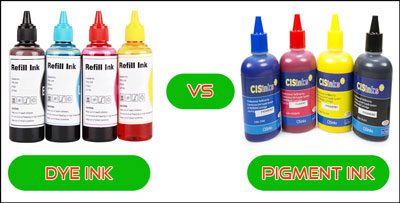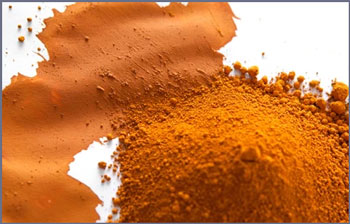
The two most common inks nowadays are dye and pigment. These are water-based inks that work for a wide array of applications, going from photography to artwork, billboards, and more.
But despite working similarly, it is still essential to consider which one between dye vs. pigment ink works better.
Here, we want to explain exactly that. You’ll learn which option works better for your needs and how you can pick the ideal one accordingly. Want to know more about dye inks and pigments inks? Then keep reading!
What Is Dye Ink?
A dye is a colorant. When someone refers to dye-based inks, they’re talking about a colorant dissolved in a liquid. Most of the time, this liquid is water. But it can also be alcohol or other chemical products to increase durability or ease of use.
Most dye inks come in a broad palette of colors and offer outstanding visual results. However, they’re known for somewhat weak against exterior factors.
To make dye-based inks easy to understand, you could say they’re like saltwater. The salt dissolves on the water, and it goes wherever the water goes without separating from it. But sure enough, whatever affects the water will also affect the dye ink.
Benefits of Using It
- Beautiful color quality
- Easy to spread and paint with
- Affordable and easy to find
- Adheres to almost any surface
Disadvantages
- Tends to fade out fast
- Not resistant to external factors
What Is Pigment Ink?
Pigment-based inks are based on super-small particles of colorant that float around in a liquid (water, alcohol, etc.). This liquid eventually gets absorbed into the paper and other surfaces, but the pigments don’t. They stay on the surface and adhere to the fibers.
This allows pigment inks to be hugely resistant and provide exceptional durability. But this also makes them somewhat dull in color.
To give you a better idea of how they work, you could think of pigment ink as fruit juice. While the liquid on the juice will get absorbed by the material, the small fruit particles will separate from the liquid and stay on the surface. This adds the resilience for pigment inks to be ideal in long-term projects. This pigment ink printer post has some additional information for pigment ink users.
Benefits of Using It
- Resistant to most exterior factors
- Can last for decades in paper
- Doesn’t fade out over time
- Dry and adhere fast to surfaces
Disadvantages
- Color can be a bit dull
- Pretty expensive & difficult to find
Dye Ink vs. Pigment Ink: The Differences
Now that you have a neat idea of what each type of ink offers, let’s now go into the deep territory and explain the different factors that truly set them apart.
Color Quality
When it comes to the overall quality of the print or traces, you’ll find that dye-based inks perform amazingly well.
The vibrancy, brightness, and overall density make dye inks outstanding for colors that rely heavily on color quality. In fact, dye inks also provide a wider array of color options, offering enough shades to tackle even the most complicated job.
At the same time, dye inks don’t have what’s called “metamerism.” This effect usually occurs on pigment inks, and it doesn’t happen on dye-based inks. What it does is change the color appearance depending on the light. The dye will always look the same, but pigment inks do not.
Having said this, while pigment inks are not as bright or vibrant and don’t hold color the same way against the light, they’re still decent. In fact, most pigment inks nowadays have incredibly reduced metamerism and can handle most jobs with no problem.
Overall, however, dye inks win when it comes to the overall quality of the print or trace.
Durability
When it comes to durability and resilience, you’ll find that dye-based inks are not the best. This happens because the dye does not hold to the fibers but instead gets absorbed. When they get absorbed, they’re more likely to break down whenever the paper breaks down, which leads to fading and smudging.
Besides, dye inks tend to be less resistant to UV rays as well as water. Constant exposition to sun rays and moisture can make dye inks lose color and blur. So they may completely mess up entire projects, especially if they’re in regular paper print or canvas.
In contrast, pigment inks hold much better into paper and other surfaces. Because they don’t get absorbed but instead adhere to the surface, they can withstand different factors that may affect the paper but not the ink.
You’re likely to find these pigment inks much more resilient against sun rays and water as well. Because they can handle most of these exterior factors, you will find them much more durable than dye inks as well. In fact, the color on pigment inks, despite being less vibrant, tends to hold better than dye inks over time.
After 10 to 50 years, the difference is outstanding. And still, the pigment may last up to 200 years in some cases.
Dye inks start fading out after the first 10 years. And after 50 years, the ink may not be the same anymore, losing a lot of its vibrancy and looking totally different from the original version. In short, we can say that pigment inks are more durable and resistant overall.
Application
If the dye is less resilient, how can I use it? Well, there are many things you can do with dye inks.
Among them, you’ll find that they work ideal for temporary projects that don’t require them to last much. For example, presentations, cards, business materials, portfolios, and other similar products that rely heavily on looks than in resilience.
The best use for dye inks is on photography paper. Because this paper is especially sturdy and resilient, there’s a high chance for the print to last longer than average. And because the paper also looks much better than regular paper, they also tend to hold the color for longer.
Then you’ll find pigment inks. The advantage of pigment is how well it sticks to almost any paper and any finish. You can find them ideal for surfaces where dye-based inks wouldn’t work, like plastics and metals.
Most pigment inks, however, are used for archiving because they can hold the color much better over time. And for any external (outdoor included) use where the surface must stay neat for long. That’s why pigments are part of what makes wall paint so useful.
To put it in a few words, dye inks offer the best results for temporary jobs, and pigment inks work better for things that need to last.
Price
When it comes to overall costs, you’ll find that they also have vast differences. For example, dye inks tend to be hugely affordable. You may not even have to think twice before getting an entire palette. Because they’re water-based most of the time, the majority of commercial dye inks are super cheap.
Pigment, on the other hand, tends to be way pricier. This happens because the pigment is more challenging to make, but also because it uses more expensive components. The pigments, for example, need specific preparation processes and are not cheap to get.
This allows dye inks to be ideal for most situations when the budget is limited. And it makes pigment helpful when money is not a problem.
Pigment Ink vs. Dye Ink: Which One to Pick?

After reading this comparison, you’re probably wondering which one to go for. But you may not have a proper decision yet. Don’t worry – we can help you out with that.
We can safely say that if you’re working on a small project that doesn’t need to last long, but you still want it to look superb, dye inks would be your best bet. And they’re cheap.
But if you prefer something more long-lasting that holds the color for years and can withstand different factors such as moisture & sun rays – then pigment ink is your best bet. Just be aware that they’re somewhat expensive.
So, what are you choosing? They are both fantastic for their specific purposes. Follow this guide and pick one!
Related Post: